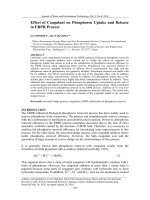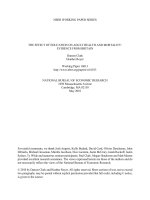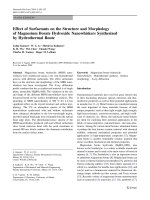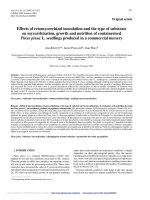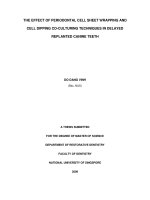Effect of urea briquettes in combination of organics on root growth and nitrogen losses in rice field
Bạn đang xem bản rút gọn của tài liệu. Xem và tải ngay bản đầy đủ của tài liệu tại đây (742.46 KB, 12 trang )
Int.J.Curr.Microbiol.App.Sci (2019) 8(1): 1463-1474
International Journal of Current Microbiology and Applied Sciences
ISSN: 2319-7706 Volume 8 Number 01 (2019)
Journal homepage:
Original Research Article
/>
Effect of Urea Briquettes in Combination of Organics on Root Growth and
Nitrogen Losses in Rice Field
Rinky Roy*, R.K. Bajpai, VinayBachkaiya, Chandan Kumar Roy,
Khagesh Joshi and Sushma
College of Agriculture, Indira Gandhi Krishi Vishwavidyalaya, Raipur, Chhattisgarh, India
*Corresponding author
ABSTRACT
Keywords
Nitrogen, Urea
briquettes,
Organics, FYM,
Rajeshwari,
Irrigated rice,
Nitrogen losses,
Root volume, Root
growth
Article Info
Accepted:
12 December 2018
Available Online:
10 January 2019
Nitrogenous fertilizers applied to soil undergo various physico-chemical and biological
transformations due to influence of different enzymes and microbial activity and thereby
become available to crops. The efficient use of nitrogen is recognized as an important
production factor for rice production but it has always been a problem to raise its
utilization rate by rice and to increase efficiency of absorbed nitrogen for grain production.
Even with the best agronomic practices only 30-40 percent of applied nitrogen is actually
utilized by the crop. A field experiment was conducted in kharif 2017 at the Research cum
Instructional Farm, Indira Gandhi Krishi Vishwavidyalaya, Raipur (C.G). Rice variety
Rajeshwari was taken as test crop under irrigated condition. The experiment was laid out
in randomized complete block design comprising of total 11 treatments; out of which, four
treatments involving application of urea briquettes, another four treatments involving
application of urea and rest three treatments involving application of briquettes of urea +
FYM, urea + vermicompost and urea + neem cake as source of nitrogen along with
varying doses of phosphorus and potassium. Each treatment was replicated four times. The
influence of the different levels and sources of Non root growth and nitrogen losses was
studied under different treatments. The results revealed that Nitrogen losses in irrigated
rice were significantly influenced by the treatments. The concentration of nitrates and
ammonia found in leachates in treatments involving urea+organics briquettes were found
significantly lower compared to rest treatments. There was a progressive increase in root
dry weight and volume with the advancement of crop growth stage. The effect of different
nitrogen levels and sources was found statistically significant on root growth. The highest
value of root volume and dry weight were found in in treatments involving urea+FYM
briquettes application. The addition of organics in urea briquettes and deep placement of
briquettes exhibited better root development and lower nitrogen losses which might be
attributed to slow release of nitrogen and thus reducing the losses and thereby higher
nutrients uptake and ultimately higher root biomass.
Introduction
Chhattisgarh is popularly known as “Rice
Bowl of India” with an area of around 3.68
million hectares and production of 8.20
million tons under rice cultivation during
kharif season which contributes 8.65% and
6.30%respectively of total acreage and
1463
Int.J.Curr.Microbiol.App.Sci (2019) 8(1): 1463-1474
production in India with productivity being
2020 kg ha-1 in 2013-14 (Anonymous, 2015).
Materials and Methods
Site description
Nitrogen is the most important nutrient in
irrigated rice production. Nitrogenous
fertilizers applied to soil undergo various
physico-chemical
and
biological
transformations due to influence of different
enzymes and microbial activity and thereby
become available to crops.
The efficient use of nitrogen is recognized as
an important production factor for rice
production but it has always been a problem to
raise its utilization rate by rice and to increase
efficiency of absorbed nitrogen for rice grain
production. Even with the best agronomic
practices, only 30-40 percent of applied
nitrogen is actually utilized by the crop.
Availability of nitrogen is a determinant factor
for the growth and yield of plants. Lowland
rice is noted for the efficient utilization of
applied nitrogenous fertilizer as compared to
upland condition and this is especially true for
top dressing of nitrogen.
The low utilization efficiency of N fertilizers
is attributed to losses like volatilization,
denitrification, leaching and surface run-off.
These losses can be reduced by management
practices like proper timing, rate and modified
forms of urea and deep placement of N
fertilizers. Several strategies have been tried to
enhance nitrogen use efficiency (NUE) in rice
including split N application, the use of slow
release N fertilizers and nitrification inhibitors
(NIs). Deep placement of N briquette at 8-10
cm depth of soil can save 30% N compared to
Prilled Urea (PU), increases absorption rate,
improves soil health and ultimately increases
rice yield (Savant et al., 1991). The present
study was undertaken to evaluate the effect of
PU, Urea briquette and Urea briquette in
combination with organics on root growth and
Nitrogen losses in rice field.
An experiment was conducted under field
conditions during kharif 2017 at the Research
cum Instructional Farm, Indira Gandhi Krishi
Vishwavidyalaya, Raipur (C.G) situated on
National highway No. 6 in Eastern part of
Raipur city and located between 200 4’ North
latitude and 810 39’ East longitudes with an
altitude of 293 m above mean sea level.The
region comes under dry and sub-humid
climatic condition. The average annual rainfall
of the area is 1400-1600 mm. The weather
data during experimental period was collected
from the meteorological observatory located at
Labhandi (IGKV), Raipur. Major precipitation
occurs between June and December (about 5-6
Months) which is the main rice growing
season. The hottest and coolest months are
May and December, respectively. Rice variety
“Rajeshwari”was used as a test crop.
Experimental soil
The experimental soil (Vertisol) is fine
montmorillonitic, hyperthermic, chromustert,
locally called as Kanhar and is identified as
Arang II series. The physico-chemical
properties of the experimental soil are
presented in Table 1.
Experiment design
The Experimental details are as follows:Treatment details
Fertilizer application
The recommended dose of Phosphorus and
Potassium fertilizers @ 60:40 kg/ha
(P2O5:K2O) was applied to the respective plots
in the form of SSP and MOP as basal dose at
the
time
of
planting.
Considering
1464
Int.J.Curr.Microbiol.App.Sci (2019) 8(1): 1463-1474
recommended dose of nitrogen @ 100 kg/ha.
using urea one-third nitrogen was applied as
basal dose, another one-third applied at
maximum tillering and rest one-third nitrogen
was applied at panicle initiation stage.
Statistical analyses
Urea briquettes application
Theroot sampling was done with the help of
core sampler. The various rooting parameters
were analyzed in laboratory.
Formation of urea briquette
Urea briquettes were made by physical
modification of normal urea fertilizer. Its
nature and properties are similar to that of urea
but it is manufactured in pillow shaped
structure and condensed with some conditions
for slow hydrolysis. Each briquette weighed
around 2.5 g with 46% N content similar to
that of PU.
Formation of urea briquette with organics
(FYM, neem cake, vermicompost)
These briquettes were prepared similarly to
that of plain urea briquettes preparation but
with some modification that 25% volume were
replaced by organics (FYM, neem cake,
vermicompost). Weight of each urea+FYM
briquettes was 2.2g, urea+neem cake
briquettes was 2.3g and urea+vermicompost
briquettes was 2.2g per briquette.
Observations taken
Root growth parameters
Root volume (ml plant-1)
Water displacement method - by dipping the
properly washed roots in a 1000 ml measuring
cylinder containing water up to a certain point,
root volume was determined by water
displacement. The root volume was measured
at depth 0-20 cm at 30, 60 and 90 DAT. The
plant sample was uprooted with root by
cylindrical shaped root sampler without
damaging the root. Before measuring the root
volume, the root was washed with tap water
and then with hydrogen peroxide for complete
removal of soil from root.
Root weight (g)
The clean roots were oven dried at 60oC and
weight was measured.
Nitrogen losses
Deep placement of urea briquettes
Full dose of Urea briquettes on weight basis
were applied after 10 days of transplanting.
For N application through USG @ 100, 75 and
50 percent RDF, one USG of 2.4 g size was
employed for every five to six (avg.5.5) hills,
seven to eight (avg. 7.3) hills and 11 hills,
respectively. In case of urea briquette with
organics (FYM, neem cake, vermicompost)
one briquette was employed for every five to
six (avg. 5.5) hills (Figure 1–3). The granules
were deep placed in the puddled soil by hand
and leveled immediately after placement.
The nitrogen losses were studied by
performing Ammonical nitrogen (NH4+-N)
and Nitrate nitrogen (NO3-N) analysis in soil
water (leachates). Leachates were collected by
installing piezometer. PVC pipes (2.5 cm in
diameter and 50 cm in length) with sealed
bottoms were installed in each field plot to
collect drainage water from the saturated soil.
pipes were perforated 66 times within 20 cm
from the bottom of the pipe. The porous zone
of the pipe was wrapped with nylon textile to
prevent sand in-filling. Comparison was done
for the inorganic N leaching in 20 cm depth.
The pipes were installed at depth of 20 cm
1465
Int.J.Curr.Microbiol.App.Sci (2019) 8(1): 1463-1474
from the surface to the uppermost pore. The
leachates accumulated in these pipes were
collected at 3, 5 and 7 days after each dose of
fertilizer application and the inorganic
nitrogen in the form of NH4-N and NO3-N
were analyzed.
The data collected from field observations
and those recorded in laboratory were
subjected to statistical analysis by standard
analysis of variance technique. For significant
treatment effects, standard error of means
(SEm ±) and critical differences were
calculated at 5 per cent level of significance.
Results and Discussion
Effect of different nitrogen levels and
sources on nitrogen losses in irrigated rice
field
Nitrogen losses in irrigated rice field were
significantly influenced by the treatments.
The observations found are presented in Table
2 and 3 as well as Figure 4 and 5. The results
revealed that highest concentration of NH4Nand NO3-Nin leachate was recorded in
treatment T8 [100% N (RDF) through
urea+100% PK (RDF)] whereas lowest value
was recorded in T9 [Urea+FYM briquettes
(75:25) + 100% PK(RDF)] followed by T10
and T11. Overall results suggests that the
treatments
involving
application
of
urea+organics briquettes minimized the
nitrogen losses in the form of NH4-Nand
NO3-Nin leachate and among them
urea+FYM briquette application resulted in
minimum Nitrogen losses. The concentration
of nitrates and ammonia found in leachates in
treatments T9, T10 and T11 were found
significantly lower compared to rest of the
treatments. The results obtained collaborated
well with the findings of Vyas et al., (1991),
Cameron et al., (2013), Fanqiao Meng et al.,
(2014) and Lihong Xue et al., (2014). Similar
findings were reported by Omar et al., (2015)
whereammonium and nitrate leaching losses
during 30 days of the leaching experiment
were highest in urea alone than in urea with
clinoptilolite, zeolite and compost treatments.
Experiment design
Location
Soil Type
Season
Crop
Variety
Treatment
Design
Replications
Net Plot size
Spacing
Instructional cum Research Farm, I.G.K.V. Raipur
Vertisols
Kharif 2017
Rice
Rajeshwari
11
Randomized complete blockdesign
Four
7m x 2m (14 m2)
20 cm x 10 cm
RDF
100:60:40 kg/ha (N: P2O5: K2O)
1466
Int.J.Curr.Microbiol.App.Sci (2019) 8(1): 1463-1474
Treatment details
Notations
Treatments
T1
50 % N through USG+ 50% PK (RDF)
T2
75% N through USG + 50% PK (RDF)
T3
100% N through USG + 50% PK (RDF)
T4
100 % N through USG+ 100% PK (RDF)
T5
50% NPK (RDF)
T6
75 % N (RDF) through urea + 50% PK (RDF)
T7
100 % N (RDF) through urea + 50% PK(RDF)
T8
100 % N (RDF) through urea + 100% PK (RDF)
T9
Urea + FYM USG (75:25 volume basis)+ 100% PK (RDF)
T10
Urea+Vermicompost USG (75:25 volume basis)+100% PK (RDF)
T11
Urea +Neem cake USG (75:25 volume basis)+100% PK (RDF)
*USG = Urea Super Granules (Briquettes)
RDF = Recommended dose of fertilizer @ 100:60:40 Kg N:P 2O5:K2O ha-1
Table.1 Physico-chemical properties of experimental soil
Particulars
Values Method
I. Physical properties
1
Sand (%)
19
2
Silt (%)
32
3
Clay (%)
49
4
Soil textural class
5
Bulk density (Mg m-3)
International pipette method (Piper 1966).
Clayey
1.51
Williams and Steinbergs (1959). Turbidimetrically.
II. Chemical properties
pH (1:2.5)
1
EC (dSm-1 at 250C)
2
7.48
0.16
Glass electrode pH meter Jackson.(1973)
Solubridge conductivity method (Black1965).
Organic carbon (%)
0.56
Rapid titration method (Walkley and Black’s 1965).
199
14.97
Alkaline permanganate method (Subbiah and Asija,
1956).
Sodium bicarbonate (Olsen et al., 1954)
3
-1
4
Available N (kg ha )
5
Available P2O5(kg ha-1)
-1
6
7
Available K2O (kg ha )
Available B (mg kg-1)
386.2
1.54
Ammonium acetate method (Jackson 1967).
Berger and Truog (1939)
8
Available S (kg ha-1)
17.76
Williams and Steinbergs (1959). Turbidimetrically.
1467
Int.J.Curr.Microbiol.App.Sci (2019) 8(1): 1463-1474
Table.2 Effect of different nitrogen levels and sources on losses of NH4-N
Treatments
T1
T2
T3
T4
T5
T6
T7
T8
T9
T10
T11
CD (P=
0.05)
Concentration of NH4-N in leachates (mg/L)
Fertilizer application at
Fertilizer application at
10 DAT
30 DAT
After 3 After 5 After 7 After 3 After 5 After 7
Days
Days
Days
Days
Days
Days
0.48
0.73
0.69
0.68
0.65
0.61
0.56
0.73
0.68
0.67
0.68
0.71
0.98
0.73
0.70
0.69
0.70
0.73
0.98
0.97
0.83
0.81
0.82
0.81
1.12
1.02
0.90
1.72
1.52
1.22
1.12
1.18
0.93
1.93
1.82
1.12
1.12
1.20
0.98
2.13
2.03
1.32
1.40
1.94
1.03
2.27
2.21
1.52
0.56
0.56
0.42
0.42
0.46
0.47
0.56
0.56
0.48
0.76
0.79
0.67
0.56
0.70
0.56
0.78
0.82
0.70
0.062
0.082
0.018
0.123
0.113
0.078
Fertilizer application at
50 DAT
After 3 After 5 After
Days
Days
7 Days
0.59
0.58
0.45
0.69
0.67
0.63
0.70
0.68
0.65
0.83
0.80
0.78
1.62
1.42
1.13
1.82
1.72
1.22
2.03
1.88
1.23
2.24
2.20
1.42
0.40
0.40
0.38
0.65
0.63
0.53
0.67
0.66
0.56
0.118
0.118
0.071
Table.3 Effect of different nitrogen levels and sources on losses of NO3-N
Treatments Concentration of NO3-N in leachates (mg/L)
Fertilizer application at
Fertilizer application at
10 DAT
30 DAT
After 3
After 5 After 7
After 3
After 5
After 7
Days
Days
Days
Days
Days
Days
0.56
0.98
0.94
0.98
0.98
0.95
T1
0.56
1.26
0.94
1.00
1.00
0.98
T2
1.12
2.80
1.96
1.96
1.96
1.82
T3
1.12
2.80
2.30
2.30
1.98
1.98
T4
1.12
3.78
3.22
4.20
4.06
2.38
T5
1.12
4.41
3.50
4.06
4.20
2.80
T6
1.12
4.95
3.86
5.08
4.88
4.00
T7
1.68
5.15
4.06
5.28
5.08
4.20
T8
0.56
0.88
0.78
0.75
0.77
0.75
T9
0.56
0.98
0.88
0.85
0.87
0.85
T10
0.56
0.98
0.93
0.90
0.92
0.90
T11
0.057
0.240
0.154
0.238
0.232
0.128
CD (P=
0.05)
1468
Fertilizer application at
50 DAT
After
After 5 After 7
3 Days Days
Days
0.97
0.96
0.94
0.99
0.98
0.96
1.80
1.80
1.78
1.98
1.86
1.98
3.92
2.50
1.98
5.02
3.64
2.24
5.06
4.00
2.46
5.26
4.20
2.66
0.77
0.74
0.70
0.84
0.86
0.84
0.89
0.91
0.89
0.260
0.202
0.093
Int.J.Curr.Microbiol.App.Sci (2019) 8(1): 1463-1474
Table.4 Effect of different nitrogen levels and sources on root growth
Treatment
T1
T2
T3
T4
T5
T6
T7
T8
T9
T10
T11
CD (P=
0.05)
Root dry weight (g/hill)
30 DAT
60 DAT
90 DAT
0.68
4.80
5.10
0.76
5.82
6.23
1.10
6.99
7.59
1.28
8.42
9.42
0.69
4.78
4.98
0.80
5.73
5.99
1.12
5.99
6.32
1.29
6.35
7.00
1.30
8.62
9.74
0.95
7.74
9.42
1.10
7.59
8.29
0.05
0.31
0.33
Root volume (cm3/hill)
30 DAT
60 DAT
90 DAT
7.85
31.92
33.11
8.15
37.83
40.49
11.30
38.93
44.74
12.26
50.52
56.52
8.90
30.83
32.89
9.50
33.80
35.34
12.20
38.10
41.08
13.00
38.70
42.68
13.30
51.84
56.52
10.40
44.40
52.44
11.15
44.38
45.11
0.53
1.92
2.04
Fig.1 Layout for Briquette application (a) Urea briquette with organics and also for 100 % RDFN through USG (b) 75% RDF-N through USG (c) 50% RDF-N through USG (d) Depth of
application of USG
(a)
(b)
(c)
(d)
1469
Int.J.Curr.Microbiol.App.Sci (2019) 8(1): 1463-1474
Fig.2 Piezometer installation (a) Making hole in plot to install piezometer (b) Installed
piezometer (c) field photograph with piezometers installed
(a)
(b)
(c)
Fig.3 Root sampling using core sampler
Fig.4 Effect of different nitrogen levels and sources on losses of NH4-N
1470
Int.J.Curr.Microbiol.App.Sci (2019) 8(1): 1463-1474
Fig.5 Effect of different nitrogen levels and sources on losses of NO3-N
Fig.6 Effect of different nitrogen levels and sources on root growth
Effect of different nitrogen levels and
sources on root dry weight (g hill-1)
There was a progressive increase in root dry
weight with the advancement of crop growth
stage up to 90 DAT. The data of dry weight of
root in g hill-1 at 30 DAT, 60 DAT and 90
DAT is presented in Table 4 and Figure 6.
The highest dry weight (1.30 at 30 DAT, 8.62
at 60 DAT and 9.74 at 90 DAT)g hill-1 was
recorded under treatment T9[Urea+FYM
briquettes(75:25)+100%PK(RDF)]followed
by
T4[100%N
through
USG+100%
PK(RDF)] whereas, lowest value was
observed inT5 [50% N (RDF) through
urea+50%PK(RDF)]. The observations at
flowering stage suggests that application of
RDF, USG and urea briquettes in combination
with organics produced significantly higher
dry-matter and dry weight of root than the
control.Similar findings have been reported
by Islam et al., (2011) and Ahmed et al.,
(2005).
Effect of different nitrogen levels and
sources on root volume (cm3hill-1)
The data of root volume (cm3hill-1) at 30
DAT, 60 DAT and 90 DAT is presented in
Table 4 and Figure 6. The highest root
1471
Int.J.Curr.Microbiol.App.Sci (2019) 8(1): 1463-1474
volume (cm3hill-1) (13.30 at 30 DAT, 51.84 at
60 DAT and 56.52 at 90 DAT) was recorded
under treatment T9[Urea+FYM briquettes
(75:25)+100% PK(RDF)] followed by
T4[100%N through USG+100% PK(RDF)]
whereas, lowest value was observed in T5
[50% N (RDF) through urea+50% PK(RDF)].
Over all the effect of different nitrogen levels
and sourceswas found statistically significant
on root volume. Similar findings were
reported by Singh et al., (1997) and Sharma et
al., (2016).
The combination of organics like FYM,
vermicompost and neem cake in urea
briquettes in treatments T9, T10 and T11
respectively provided better physic-chemical
and biological soil condition to plant and
briquette formation reduced the surface area
of applied N- fertilizer, also deep placement
of briquettes induced slow release of nitrogen,
thusreducing the nitrogen losses in the form
of ammonia and nitrates in soil water
leachate, thereby higher nitrogen uptake and
ultimtely produced higher root biomass. The
treatment T9 performed better due to slow
and regular release of nitrogen as briquettes
with organics provide better nutrient use
efficiency and minimum nutrient losses so
that plant can easily uptake nutrient in their
critical growth period. Similar result was
reported by Mishra et al., (1999),
Laxminarayana (2006), Yadav et al., (2014)
and Sunitha et al., (2010) and Chesti et al.,
(2015). Overall findings indicate that,
Urea+FYM briquette application among
different sources of fertilizer nitrogen was
found most suitable for irrigated ricein terms
of better root growth and minimum nitrogen
losses.
Acknowledgements
Authors are thankful to the Head, Department
of Soil Science and Agricultural Chemistry,
Dean, College of Agriculture, Indira Gandhi
Krishi Vishwavidyalaya, Raipur (C.G) for
providing the necessary facilities in
accomplishing the research work.
References
Ahmed, M., Islam, Md. M. and Paul, S. K. 2005.
Effect of nitrogen on yield and other plant
characters of local T. aman rice, var. jatai.
Research Journal of Agriculture and
Biological Sciences, 1(2): 158-161.
Aulakh, M. S., Doran, J. W., and Mosier, A. R.
(1992).
Soil
denitrification:
Significance,measurement, and effects of
management. Adv. Soil Sci. 18:1–57.
Bajpai, R.K., Chitale, S., Upadhyay, S.K. and
Urkurkar, J.S. 2006. Long-term studies on
soil physico-chemical properties and
productivity of rice-wheat system as
influenced
by
integrated
nutrient
management in Inceptisol of Chhattisgarh.
J.Indian Soc. Soil Sci. 54(1): 24-29.
Cassman, K.G.S., Peng, S., Olk, D.C., Ladha,
J.K., Reichardt, W., Doberman, A., Singh,
U. 1998. Opportunities for increased
nitrogen use efficiency from improved
resource management in irrigated rice
systems. Field Crops Res. 56:7-38.
Cameron, K.C., Di, H.J., Moir, J.L. 2013.
Nitrogen losses from the soil/plant system.
Annals of Applied Biology, 162(2):145-173.
Chesti, M.H., Kohli, A., Mujtaba, A., Sofi, J.A.,
Nazir Q.T., Peer, Q.J.A., Dar, M.A. and
Bisati, I.A. 2015. Effect of integrated
application of inorganic and organic sources
on, soil properties, yield and nutrient uptake
by rice (Oryza sativa L.) in intermediate
zone of Jammu and Kashmir. J. of the Indian
Society of Soil Sci. 63(1): 88-92.
Choudhury, A., Bhuiyan, N.I., Hashem, M.A.,
Matin, M.A. 2009. Nitrogen fertilizers deep
placement in wetland rice. Bangladesh
Research Publication Journal 2(2): 499-505.
Ciampitti, I.A. and T.J. Vyn. 2012. Physiological
perspectives of changes over time in maize
yield dependency on nitrogen uptake and
associated nitrogen efficiencies: A review.
Field Crops Res. 133: 48-67.
Das, S. and Singh, T.A. 1994. Nitrogen use
efficiency by rice and flood water
1472
Int.J.Curr.Microbiol.App.Sci (2019) 8(1): 1463-1474
parameters as affected by fertilizer
placement techniques. Journal of Indian
Society of Soil Science 42(1): 46-50.
Derrick, B.E., Etienne, I., Mathusalem, K. 2017
Comparative Study of Urea in Prilled and
Briquette Forms on Rice Production in
Marshlands of Rwanda. J Fert. Pest. 8: 178.
Gomez, A.K and Gomez, A.A. 1984. Statistical
Procedures for Agriculture Res. A wileyInter Sci. Publication. Johan Wiley and
Sons, New York.
Hasan, S.M. 2007. Effect of level of urea
supergranules on the performance of T.
aman rice. M. Sc. Ag. Thesis in Agronomy,
BAU, Mymensingh.P:72-85.
Islam, M.S., Rahman, F. and Hossain A.T.M.S.
2011. Effects of NPK Briquette on Rice
(Oryza sativa) in Tidal Flooded Ecosystem.
The Agriculturists 9(1&2): 37-43(2011)
ISSN-1729-5211 A Scientific Journal of
Krishi Foundation.
Jena, D., Misra, C., Bandyopadhyay, K.K. 2003.
Effect of prilled urea and urea super granules
on dynamics of ammonia volatilization and
N use efficiency of rice. Journal of Indian
Society of Soil Science 51(3): 257-261.
Darade, A.B. and K.B. Bankar. 2009. Effect of
Urea-DAP briquettes and zinc levels on
nitrogen, phosphorus and potassium uptake
and yield of hybrid rice. Int. J. Agric.Sci.
5(2): 510-512.
Devi Joshna M.C., Anurag, Surekha, K., Bajpai,
R.K. and Kumar R. 2017. Studies on
Nitrogen use efficiency in irrigated rice as
influenced by various sources of Nitrogen.
International Journal of Chemical Studies,
5(4): 1278-1281.
Gupta, V., Sharma, R.S., and Vishvakarma, S.K.
2006. Long-term effect of integrated nutrient
management on yield sustainability and soil
fertility of rice (Oryza sativa)-wheat
(Triticum aestivum) cropping system. Indian
Journal of Agronomy, 51: 160-164.
Hanway, J. J. and Heidel, H. 1952. Soil analyses
methods as used in Iowa State College Soil
Testing Laboratory. Iowa Agric, 57: 1–31.
Kapoor, V., Singh, U., Patil, S. K., Magre, H.,
Shrivastava, L. K., Mishra, V. N., Das, R. O.
Samadhiya, V. K., Sanabria J. and Diamond,
R. 2008. Rice Growth, Grain Yield and
Floodwater Nutrient Dynamics as Affected
by Nutrient Placement Method and Rate.
Agronomy Journal. 100(3): 526-536.
Kumar, A., Meena, R.N., Yadav, L. and Gilotia,
Y.K., 2014. Effect of organic and inorganic
sources of nutrient on yield, yield attributes
and nutrient uptake of rice cv. PRH-10. The
Bioscan, 9(2): 595-597.
Laxminarayana K and Patiram 2006. Effect of
integrated use of inorganic, biological and
organic manures on rice productivity and
soil fertility in Ultisols of Mizoram. J. Indian
Soc. Soil Sci. 54(2): 213-220.
Lihong Xue, Yingliang Yu and Linzhang Yang
2014.Maintaining yields and reducing
nitrogen loss in rice–wheat rotation system
in Taihu Lake region with proper fertilizer
management.
Environmental
Research
Letters, 9(11).
Meng, F., Olesen, J.E., Sun, X., Wu,W., 2014.
Inorganic Nitrogen Leaching from Organic
and Conventional Rice Production on a
Newly Claimed Calciustoll in Central Asia.
Bond-Lamberty B, ed. PLoS ONE, 9(5):
e98138. doi:10.1371/journal.pone.0098138.
Miah, I., Chowdhury, M.A.H., Sultana, R.,
Ahmed, I. and Saha, B.K. 2012. Effects of
prilled urea and urea super granule on
growth, yield and quality of BRRI dhan28. J.
Agrofor. Environ., 6 (1): 57-62.
Mishra, B.K., Mishra, S., Dash, A.K., and Jena,
D. 1999. Effect of time for urea super
granule (USG) placement on lowland rice.
Annals Agricultural Research, 20(4): 443447.
Olsen, S.R., Cole, C.V. Watnable F.S. and Dean,
L.A. 1954. Estimation of available
phosphorous in soils by extraction with
sodium carbonate. U.S.D.A. Cir.No.933: 110.
Omar et al., 2015. Improving Ammonium and
Nitrate Release from Urea Using
Clinoptilolite Zeolite and Compost Produced
from Agricultural Wastes. The Scientific
World Journal, Article ID 574201.
Pengfei Li et. al. 2018. Nitrogen losses, use
efficiency, and productivity of early rice
under controlled-release urea.Journal of
Agriculture, Ecosystems & Environ.,
251:78-87.
Piper, C.S. 1966. Soil and Plant Analysis, Hans.
Pub. Bombay. Asian Ed. pp. 368-374.
1473
Int.J.Curr.Microbiol.App.Sci (2019) 8(1): 1463-1474
Rodgers, G.A. 1986. Nitrification inhibitors in
agriculture. Journal of Environmental
Science and Health. Part A: Environmental
Science and Engineering. 21(7): 701-722.
Roy, Rinky, Bajpai, R.K. and Bachkaiya, V. 2018.
Assessment
of
urea
briquettes
in
combination with organics on rice
productivity under irrigated conditions.
Trends in Biosciences Journal.11(30):36123614.
Roy, Rinky, R.K. Bajpai, Vinay Bachkaiya,
Chandan Kumar Roy, Minakshi Sahu, Neha
Padhi and Ankita Tirkey. 2018. Evaluation
on Impact of Use of Urea Briquettes in
Combination of Organics on Nutrient Use
Efficiency
in
Irrigated
Rice.
Int.J.Curr.Microbiol.App.Sci. 7(12): 14641479.
doi:
/>4
Savant, N.K. and Stangel, P.J. 1990. Deep
placement of urea super granules in
transplanted rice: principles and practices.
Fertilizer Research, 25: 1 – 83.
Sharma, U., Subehia, S.K. and Rana, S.S., 2016.
Long term effect of integrated nutrient
management on yield and economics of rice
(Oryza sativa L.)-wheat (Triticum aestivum
L.)
system
in
north-western
Himalaya. Research on Crops, 17(2):173177.
Singh, R., Tripathi, R.P. and Sharma, J.C., 1997.
Rooting pattern and yield of rice (Oryza
sativa L.) as influenced by soil water
regimes. Journal of the Indian Society of
Soil Science, 45(4): 693-697.
Subbaiah, B.V and Asija, G.L. 1956. A rapid
procedure of estimation of availablenitrogen
in soils.Current Science, 65(7): 477-480.
Subbiah, S., Ramanathan, K.M. and Francis, H.J.
1979. Influence of neem cake-coated urea
application on the yield and nutrient uptake
by IR20 rice. International Rice Commission
Newsletter, 28(2): 15-19.
Sunitha, B.P., Prakasha, H.C. and Gurumurthy,
K.T. 2010. Influence of organics, inorganic
and their combinations on availability,
content and uptake of secondary nutrients by
rice crop (Oryza sativa L.) in Bhadra
Command, Karnataka. Mysore Journal of
Agricultural Sciences 44(3): 509-516.
Vyas, B.N., Godrej, N.B. and Mistry, K.B. 1991:
Development and evaluation of neem extract
as a coating for urea fertiliser. Fertiliser
News, 36(2).
Yadav, S.K. and Saha, B. 2014. Partial
substitution of nitrogenous fertilizer through
organics enhances yield, nutrient uptake and
physiological characteristics of transplanted
rice (Oryza sativaL.) integrated nutrient
management
after
rainfed
cropping
sequence. Indian J. Agric. Res, 45 (4): 346 –
349.
Yawalkar, K. S., Agrawal, J. P. and Bokde, S.
1996. Commercial nitrogenous fertilizers.
Manure and fertilizers, 8(4): 96-97.
Zhang, J., Qin, J., Yao, W., Bi1, L., Lai, T. and
Yu, X. 2009. Effect of long-term application
of manure and mineral fertilizers on nitrogen
mineralization and microbial biomass in
paddy soil during rice growth stages. Plant
Soil Env., 55(3): 101–10
How to cite this article:
Rinky Roy, R.K. Bajpai, VinayBachkaiya, Chandan Kumar Roy, Khagesh Joshi and Sushma.
2019. Effect of Urea Briquettes in Combination of Organics on Root Growth and Nitrogen
Losses in Rice Field. Int.J.Curr.Microbiol.App.Sci. 8(01): 1463-1474.
doi: />
1474
